Quick Info:
MIDI-plant

Scrap Tire Recycling
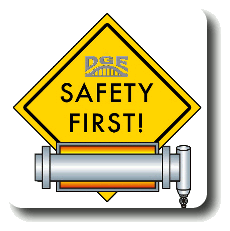
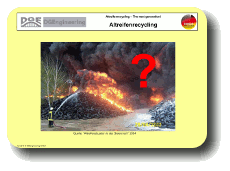
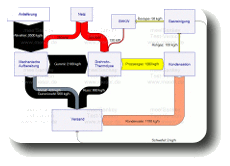
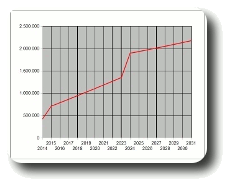


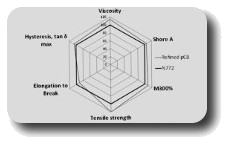
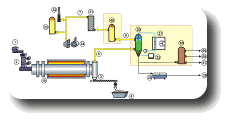
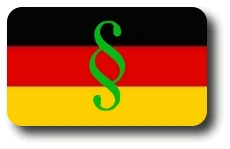
|
 |
 |
 |
 |
|
|
 |
| Dirk Gerlach Engineer
|
|
|
|
|
Why T-Rec waste processing?
 |
Household waste is a heterogenous mixtures of different kinds of materials:
- wet and dry material
- organic and anorganic
- high and low calorific
- hazardous and non hazardous
- easy and bad recyclable
In conventional way all the waste will be burned and from the heat energy there will be produced electric energy.
In best case there is a presorting to get recyclables.
|
Since the last 20 years the waste sorting and handling technologies are developt to high efficiency, so that it is mostly cheaper to organise a complex small scale waste handling factory, than huge thermal plants.
Rotary kiln thermolysis is NOT the onliest way of technology to be happy. No, but in combination with other technologies the DGE-MIDI-plants can create a interesting benefit.
Dry material thermolysis
Best input for thermolysis is dry material with a water content of less than 10%.
The technology allows also an operation with sludge and more than 90% water content, but the efficiency is for devil.
The DGE-MIDI-plants will extract the water from the oil, so that a input water content of 20% is mostly acceptable.
|
Wet material thermolysis
For high efficiency wet materials must be processed before thermal treatment!
There are different ways:
- drying to keep out of free water
- fermentation to keep out of cellular water
|
Thermal drying
Thermal drying need appr. 800 kWh per ton of water evaporation!
Thermal drying systems needs a lot of expensive equipment:
- steam dryers need pressure prooven designs and mostly condensation units
- warm air dryers need gas filtering and controls to prevent hazardous bacterias
But you can reach a water content of less than 5% !
|
Mechanical drying
Most of mechanical drying systems needs less than 20 kWh per ton of water separation.
Most of the mechanical filter presses only reach water contents of appr. 60%.
A special press reach water contents of less then 20% water content, but need special structurized material or in case of sewage sludge a predried material.
|
Wet sorting
Wet sorting causes often a lot of problems with optical detecting systems in reason of splashing wet particles. Therefor you need (daily) cleaning.
|
Dry sorting
Dry sorting is much more easier and more econimic (less maintenance), but needs a preparation.
In normal case fine particles are almost wet and large particles are almost dry, so a simple screening can help a lot.
|
Organic Thermolysis
Organic material (and also some plastics) contains a high content of chemical oxygen.
During thermolyis process a higher water content will be build in the process gas and during condensation in the oil.
For conventional pyrolysis systems this have no dramatic effect, but while condensation the water and often acetic acid content reduce the oil quality.
The DGE-MIDI-plant enclosed some rectification columns to get fine condensates.
|
Anorganic Thermolysis
For thermolysis the chemical structure of the input has to be checked:
- Are there oxygen included -> water building!
- Are there halogens included -> check cracking temperature of molecules, because most of the chlorids are stable at our process temperatures!
- Is sulphur included -> check cracking temperature of molecules!
Due to the given input chemical the output qualities will change.
Further information you will find here.
|
Gas heated thermolysis
Due to the experience of existing gas heated plants, there is a interlocking of different process parameters.
- First: Is there enough gas energy for heating from the process or due we need additional energy?
- Second: It is possible to get flat process parameters for stable processes?
In any case you need much more gas energy (esp. at high process temperatures) than the thermolysis precess need, so you have a high amount of heat losses.
|
Electrical heated thermolysis
Electric heated kilns are very stable in the process conditions!
Also there are only very small heat losses, because there is no offgas from burners.
With electrical heated kilns and a good process control system it is possible to combine thermolysis with renewable energy sources!
In case of combination with PV or wind power the heat losses in total are nearly zero!
More detailed information you will find here.
|

Read more in this presentation.
|
Feel free to contact us for coopration in following technologies:
- Non conventional bio fermentation
- Bio technolgies (ex.g. algae)
- Gas treatment/upgrading
- Catalytic processes
- Water cleaning
- Renewable power solutions
- Sorting technologies
- upgrading technologies
|
|
|
|
Dipl.-Ing.(FH) Dirk Gerlach • Passion for Innovation
|
|  |
 |
 |
 |
|
|
A Service of LEO GmbH.
|



















